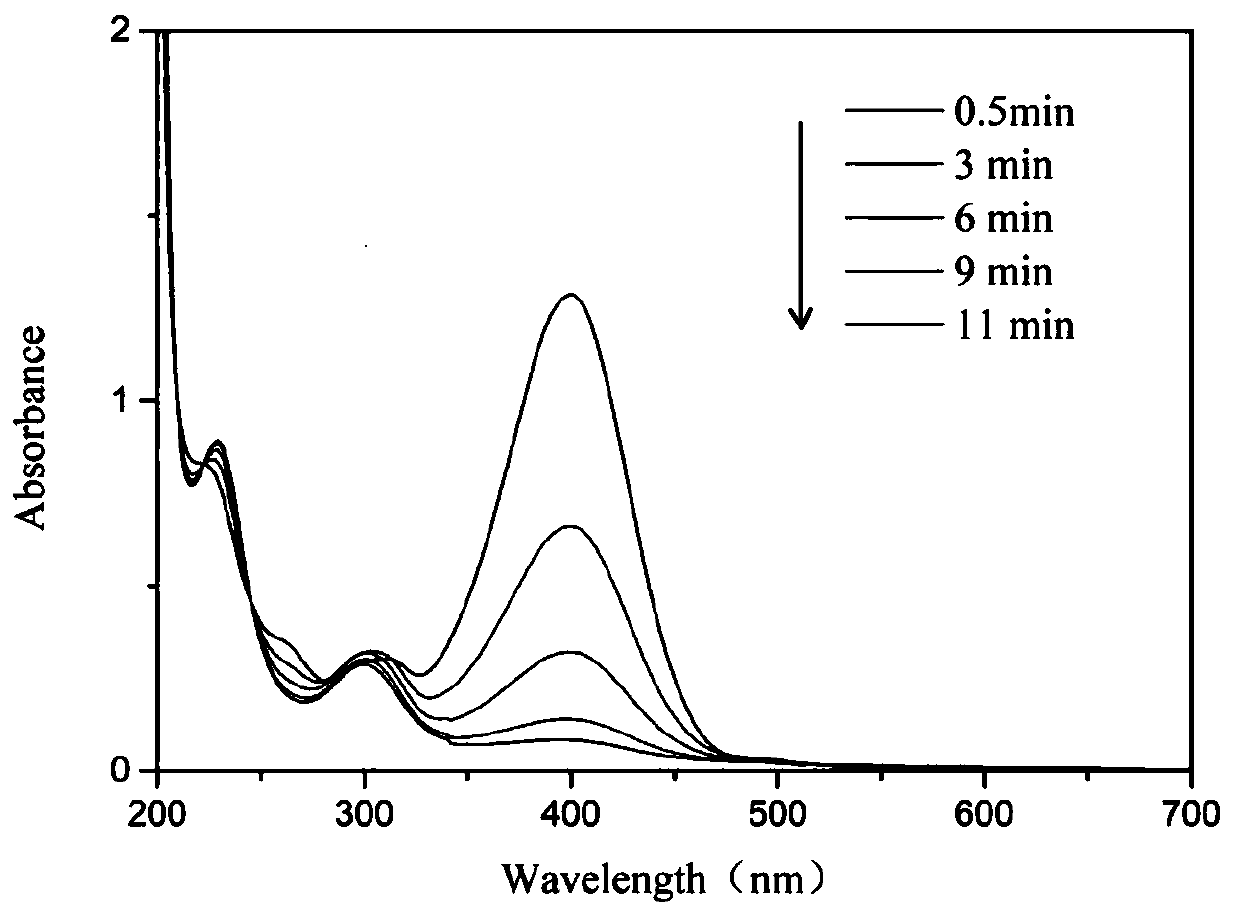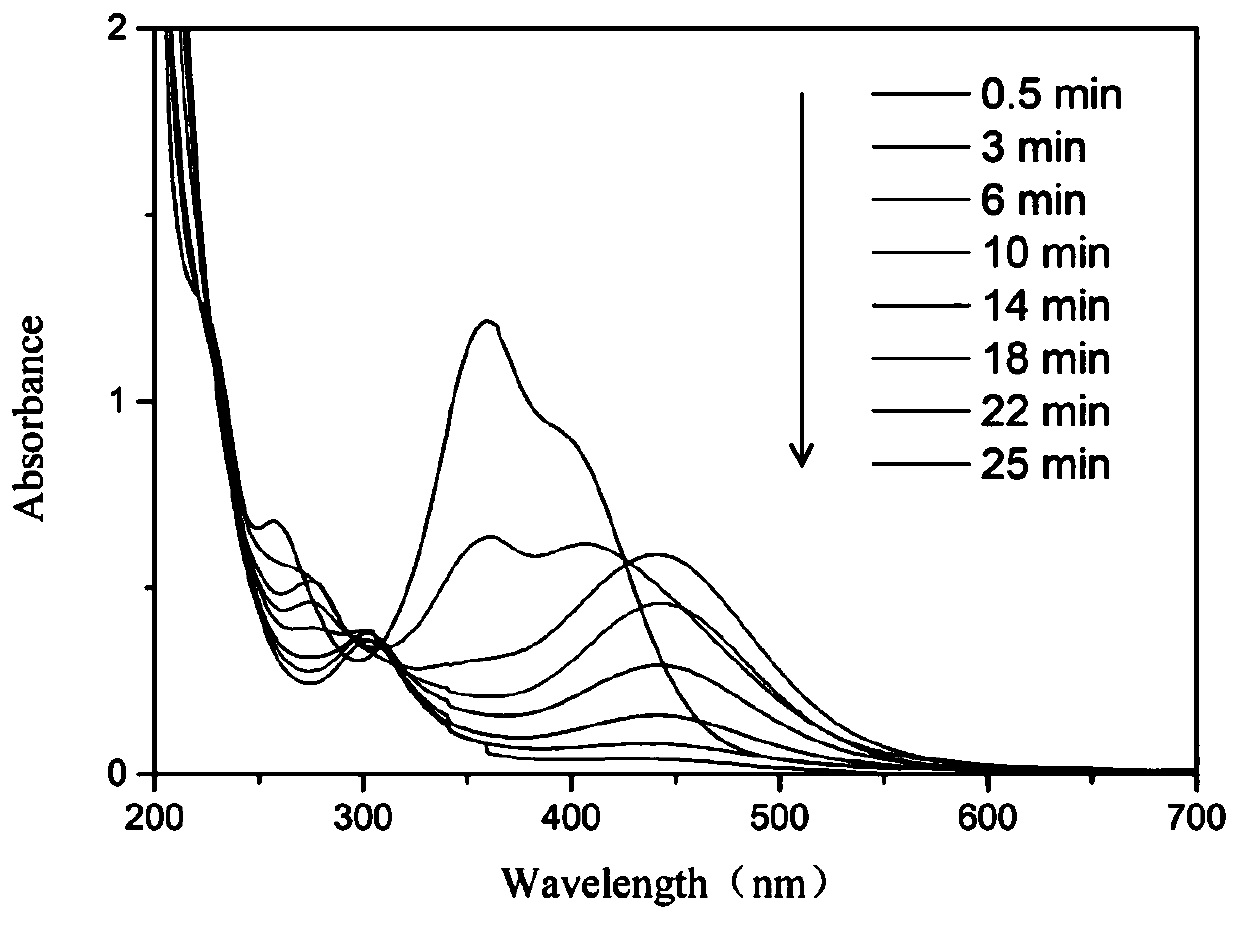Method for preparing graphene quantum dot stabilized silver-rhodium bimetallic nanoparticles and application of nanoparticles
A graphene quantum dot, bimetallic nanotechnology, which is applied in the preparation of organic compounds, chemical instruments and methods, preparation of amino hydroxyl compounds, etc. The effect of suppressing self-agglomeration and saving costs
- Summary
- Abstract
- Description
- Claims
- Application Information
AI Technical Summary
Problems solved by technology
Method used
Image
Examples
Embodiment 1
[0054] Step 1: Take 1ml of graphene quantum dot solution, add it to the reagent bottle, and stir for 5 minutes.
[0055] Step 2: Add 2ml of deionized water and stir for 5 minutes.
[0056] Step 3: add 1ml sodium borohydride solution, the amount of added sodium borohydride substance is 20 times of the sum of the amount of silver nitrate and rhodium nitrate mixed solution substances added in step 4. The rate of addition is 1-5 minutes per milliliter.
[0057] Step 4: add 1ml silver nitrate and rhodium nitrate mixed aqueous solution, the amount summation of added silver nitrate and rhodium nitrate mixed aqueous solution substance is 2.5 * 10 -4 mmol, the ratio of silver nitrate and rhodium nitrate is 1:1, the volume ratio is 1:1, and the dropping speed is 1-5 minutes per milliliter. Then stir for 2-3 hours. Graphene-stabilized silver-rhodium bimetallic nanoparticles were prepared. Take a sample to make a characteristic electron microscope scanning picture.
[0058] figure 1...
Embodiment 2
[0060] The application of the novel graphene quantum dot-stabilized silver-rhodium bimetallic nanoparticle catalyst obtained in Example 1 of the present invention in catalytic degradation of p-nitrophenol and sodium borohydride reaction.
[0061] The reduction of p-nitrophenol catalyzed by silver-rhodium bimetallic nanoparticles proceeds according to a leaching mechanism, i.e. not on the surface of the nanoparticles but in small clusters of silver-rhodium bimetallic atoms or separated from the parent silver-rhodium bimetallic nanoparticles superior. In the first step, sodium borohydride is decomposed by hydrolysis to generate B(OH) 4 - and active hydrogen, and then the active hydrogen is transferred to the silver-rhodium bimetallic nanometer and adsorbed on the surface of the silver-rhodium bimetallic nanometer; finally, the active hydrogen on the surface of the silver-rhodium bimetallic nanometer reacts with p-nitrophenol to generate p-aminophenol.
[0062] The silver-rhodi...
Embodiment 3
[0071] Application of the novel graphene quantum dot-stabilized silver-rhodium bimetallic nanoparticle catalyst obtained in Example 1 of the present invention in catalytic degradation of 2,4-dinitrophenol and sodium borohydride.
[0072] The reduction of 2,4-dinitrophenol catalyzed by silver-rhodium bimetallic nanoparticles proceeds according to a leaching mechanism, i.e. not at the surface of the nanoparticles but at the silver-rhodium bimetallic atoms or separated from the parent silver-rhodium bimetallic nanoparticles on small clusters. In the first step, sodium borohydride is decomposed by hydrolysis to generate B(OH) 4 - and active hydrogen, and then the active hydrogen is transferred to the silver-rhodium bimetallic nanometer, adsorbed on the surface of the silver-rhodium bimetallic nanometer; finally, the active hydrogen on the surface of the silver-rhodium bimetallic nanometer reacts with 2,4-dinitrophenol to generate 2,4 - Diaminophenol.
[0073]
[0074] The st...
PUM
| Property | Measurement | Unit |
|---|---|---|
| size | aaaaa | aaaaa |
| particle diameter | aaaaa | aaaaa |
Abstract
Description
Claims
Application Information
 Login to View More
Login to View More - R&D
- Intellectual Property
- Life Sciences
- Materials
- Tech Scout
- Unparalleled Data Quality
- Higher Quality Content
- 60% Fewer Hallucinations
Browse by: Latest US Patents, China's latest patents, Technical Efficacy Thesaurus, Application Domain, Technology Topic, Popular Technical Reports.
© 2025 PatSnap. All rights reserved.Legal|Privacy policy|Modern Slavery Act Transparency Statement|Sitemap|About US| Contact US: help@patsnap.com



